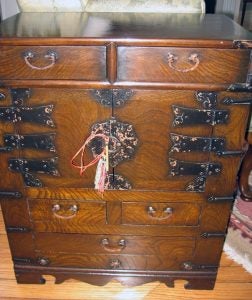Personal Effects, April 07
Published 6:51 am Saturday, April 7, 2018
Question: I’d like your opinion of this little Asian chest, Jerry. I bought it at an auction where most items were good antiques. The metal hardware looked aged and the back and interior are lined with old paper covered in what I assume are Chinese characters, handwritten in black ink.
On closer inspection when I got it home, the inside of the drawers looks new. It measures 19 inches wide by 23 inches high by 12 inches deep.
Even if it isn’t an antique, it’s perfect beside a chair and I love the look of it. Wish I knew what that writing says!
Answer: You know, I’m puzzled over this one too. First off, it’s a precious little chest. I can see how you’d love its handy, small size. Smaller sized pieces are always in demand with today’s changing demographics and downsizing seniors.
This is a tansu-style chest. Tansu chests were used in Japan, but also other Asian countries. Not only did they serve as furniture but doubled as room dividers and stair steps. They fit together like puzzle pieces. In Japan, space is always at a premium and these pieces were designed to be easily moved and positioned to suit one’s needs. 

Early tansu pieces can date back centuries. Your piece was a type of dressing chest. It would have held folded garments, accessories and other fine things. They usually have handles on the sides for easy moving and from your photos I can’t tell if your chest has them or not.
I agree with you the interior looks absolutely new. But the one thing that makes me think other wise is the wood. The wood is some type of finely grained Asian wood. Forgive me, but my knowledge of Oriental woods is sorely lacking.
I would wager that it’s an elm wood. It’s gorgeous. Have you noticed that it’s matching. Its front was made one solid piece of wood. Not from an assembly of wood, as all the grain matches and continues to flow. This is a sign of quality, fine wood and fine construction.
The paper looks to me as though it’s printed and not handwritten. And it tries desperately to look “old.” If you think my skills in Asian woods are lacking, you should see my skills in deciphering Japanese writing.
The hardware looks slightly hinky to me too. Still I like it. I’m going to say that based on the wood and the construction, that it’s going to date to the 1930s. Pieces like this are still manufactured today. Pieces that are real furniture and not just fakes meant to deceive.
I don’t know what you paid for it. However, I wager that in a retail store that carries vintage or good quality, traditional Asian furniture, it would be priced at about $300. It’s a great piece and please keep using by your favorite chair. Thanks for sharing it with us.





